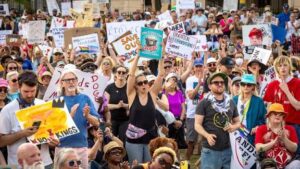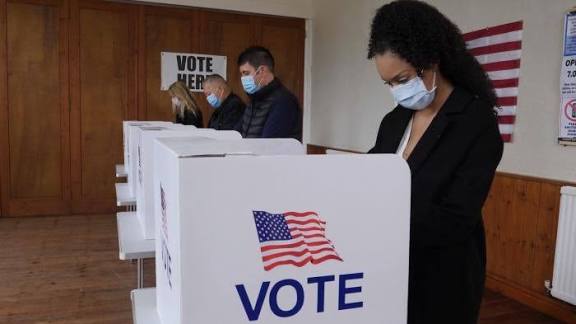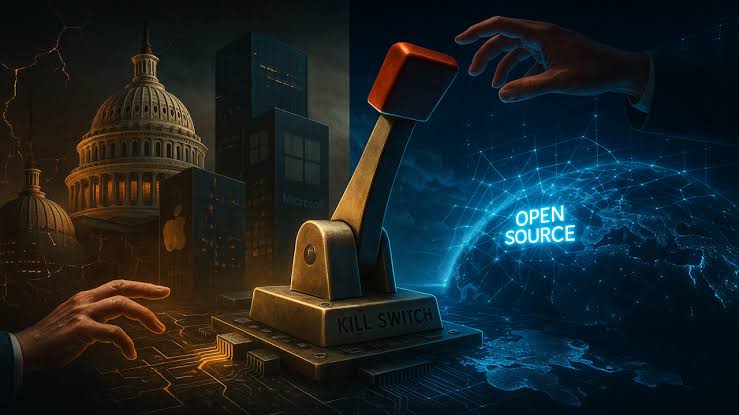50501 “No Kings” Movement Explodes Nationwide

President Trump’s birthday parade was overshadowed by protests in every state and around the world. His attempt to turn the coronation on 14 June failed. Today we will discuss about 50501 “No Kings” Movement Explodes Nationwide
50501 “No Kings” Movement Explodes Nationwide
In 2025, a sweeping protest movement erupted across the United States under a striking name: 50501, commonly known as the “No Kings” movement. What began as a decentralized grassroots effort quickly expanded into one of the largest, most widespread protest actions in modern American history. With millions mobilizing in over two thousand cities, the movement represents a vast, diverse outpouring of concern over rising authoritarianism, executive overreach, and threats to democratic institutions.
This article examines the origins, goals, events, symbolism, and broader political significance of the 50501 / No Kings movement—and why it has become a defining political force of 2025.
What Is the 50501 Movement?

Meaning and Origins
The term 50501 stands for “50 protests, 50 states, one movement.” It emerged from a coalition of local activists determined to create simultaneous, coordinated protest actions across all U.S. states. The movement does not function like a traditional political organization. Instead, it is a decentralized network of local hubs—volunteer-based, community-led teams that coordinate their own events and messaging.
Despite having no formal leader, 50501 quickly became a recognizable national brand for civic resistance. The companion slogan “No Kings” captures the movement’s defining message: a rejection of executive overreach and a reaffirmation of democratic governance.
Why Protesters Mobilized
Although diverse in membership, the movement is united around several shared concerns:
1. Rising Authoritarianism
Participants argue that the federal government—particularly under President Donald Trump’s second administration—has shown increasingly authoritarian tendencies. Actions such as expanded executive authority, attempts to weaken institutional checks, and aggressive rhetoric toward critics have fueled widespread alarm.
2. Militarization of Political Messaging
A major catalyst for nationwide mobilization was the announcement of a highly publicized military parade marking the U.S. Army’s 250th anniversary. The date coincided with President Trump’s 79th birthday, a pairing critics viewed as dangerously reminiscent of authoritarian propaganda.
3. Threats to Civil Liberties
Activists highlight growing concerns around:
immigration crackdowns,
aggressive federal law enforcement,
surveillance expansion,
politically motivated prosecutions,
and weakening of civil-rights protections.
4. Economic Inequity and “Billionaire-First Politics”
Protesters argue that government policies increasingly prioritize corporations and wealthy elites—while underfunding public services, healthcare, education, and social welfare.
5. Defense of Democratic Institutions
The “No Kings” message explicitly asserts that no president—regardless of ideology—should hold unchecked power. The movement frames its protests as a patriotic defense of constitutional norms.
Timeline of Major Protests
Early 2025 — Initial Mobilization
February 5, 2025: The first coordinated 50501 protests occur in all 50 states. Participation surprises even the organizers, with large crowds gathering in major cities and many rural towns.
February 17, 2025 (Presidents Day): Rebranded as “No Kings Day,” this second wave of protests expresses anger over executive overreach and billionaire influence over government operations.
Spring 2025 — Rapid Growth
March 4, 2025: A third national action day. By this point, hundreds of local hubs are organizing independently.
April 5, 2025: Over 1,200 protest locations participate in a unified “Hands Off!” event.
April 19, 2025: Growing momentum leads to a fourth coordinated protest day, as more civic organizations join the coalition.
June 14, 2025 — First National “No Kings Day”
This becomes a historic turning point.
Protests occur in over 2,100 cities and towns.
More than 5 million people participate nationwide.
It becomes one of the largest single-day protest events in modern U.S. history.
Demonstrations are overwhelmingly peaceful, featuring patriotic themes, music, and community gatherings.
The symbolic date—Trump’s birthday and a major military anniversary—helps cement the event’s national visibility.
July 4, 2025 — Free America Weekend
Instead of centralized marches, activists encourage decentralized celebrations tied to traditional Independence Day festivities. Citizens are urged to incorporate “No Kings” themes into local parades, cookouts, concerts, and community gatherings.
This strategy expands the movement into rural and suburban communities.
October 18, 2025 — Second Nationwide Protest
The October protests eclipse previous events in scale:
2,700+ planned protest locations across all 50 states.
Estimated turnout: 5 to 7 million people nationwide.
Hundreds of partner organizations join, including civil-liberties groups, teachers’ unions, labor coalitions, climate groups, and grassroots democracy networks.
Major cities report enormous turnout—Boston alone sees more than 125,000 attendees.
This protest day firmly establishes 50501 as the dominant protest movement of the year.
Who Organizes 50501?
A Decentralized Structure
The movement is intentionally leaderless. Instead of a central command hierarchy, it uses:
local hubs,
volunteer coordinators,
community networks,
and partner organizations.
This structure makes the movement extremely adaptable. Even if one hub were to dissolve, others can continue autonomously.
Key Coalition Partners
Hundreds of groups participate, including:
grassroots political networks,
civil-rights organizations,
teachers’ unions,
environmental and climate groups,
senior-citizen advocacy groups,
voting-rights organizations,
local neighborhood coalitions.
Some well-known national organizations support the protests by providing legal resources, communications support, and training for nonviolent civil disobedience.
No Single Leader
The absence of a central leader is deliberate. Organizers emphasize that democracy must come from the community—not from a heroic figure. This also protects the movement from political targeting or centralized suppression.
What Protesters Want
Though diverse, participants share several core demands:
1. Limit Executive Overreach
Protesters argue for stronger checks on presidential power, including judicial independence, legislative oversight, and protections against the politicization of the military.
2. Protect Civil Liberties
They demand stronger safeguards for immigrants, whistleblowers, journalists, and activists—groups they believe face heightened risk in authoritarian political climates.
3. Strengthen Democratic Safeguards
This includes:
defending voting rights,
protecting free speech,
ensuring nonpartisan election administration,
reversing gerrymandering,
and preventing intimidation of political opponents.
4. Address Economic Inequality
Many protesters advocate policies such as:
higher taxes on the ultra wealthy,
restrictions on corporate influence in government,
stronger social safety nets,
and protections for workers.
5. Uphold Nonviolent Resistance
The movement consistently promotes peaceful protest. Training in de-escalation and civil disobedience is widely offered through partner organizations.
Symbolism and Messaging
Why “No Kings”?
The phrase is a deliberate reference to America’s founding principles. Protesters argue that the nation was built specifically to prevent concentrated, monarchical power. The slogan frames their cause not as partisan opposition, but as a patriotic defense of the republic.
Symbols Used in Protests
Crowns with slashes — representing rejection of authoritarianism.
American flags — reclaiming patriotism for democratic values.
Giant puppets and creative satire — including a satirical “Trump on a golden throne” figure appearing at several rallies.
Historical references — including quotes from founding fathers warning against tyranny.
Community-Focused Activism
The movement emphasizes local empowerment—block parties, musical events, teach-ins, voter-registration drives, art installations, and community service events often accompany the protests.
Conflicts and Challenges
1. Tensions with Law Enforcement
While the majority of protests remain peaceful, some cities declare assemblies unlawful or deploy crowd-control tactics, leading to isolated confrontations. Organizers accuse authorities of overreacting, while government officials claim they are responding to safety risks.
2. Media Narratives
Coverage varies widely. Some outlets portray the movement as a historic defense of democracy; others characterize it as disruptive, radical, or partisan. This media fragmentation influences public perception.
3. Political Opposition
Critics—particularly conservative political leaders—argue the movement is a partisan attempt to undermine the government. Some officials warn of potential unrest, though widespread violence has not materialized.
4. Maintaining Momentum
As with all mass protest movements, sustaining energy, volunteer labor, and public interest is a challenge. Organizers debate how to convert mass mobilization into long-term political impact.
Scale and Impact
Unprecedented Geographic Reach
The June 14 and October 18 protests together reached nearly every region of the country, including:
major metropolitan areas,
small towns,
rural counties,
military communities,
suburbs traditionally uninvolved in activism.
Millions Mobilized
The movement’s peak events involve:
2,100+ towns (June)
2,700+ towns (October)
5–7 million protesters nationwide
These numbers place 50501 among the largest coordinated protest waves in U.S. history.
Political and Cultural Impact
The movement has reshaped national conversations about:
authoritarianism,
democratic norms,
civil resistance,
the limits of presidential power,
and the rights of citizens to dissent.
The widespread use of patriotic imagery challenges assumptions that protest movements are anti-American—reframing activism as a civic duty.
The 3.5% Rule
Movement organizers often invoke the “3.5% rule,” a well-known social-movement theory suggesting that when approximately 3.5% of a population participates in sustained, nonviolent activism, major political change becomes likely.
For the U.S., this threshold is about 12 million people.
With multi-million–person turnout, activists argue that 50501 is on its way to meeting this theoretical tipping point.
Broader Implications
1. Reinvention of Grassroots Activism
The success of decentralized organizing demonstrates that large-scale movements do not require hierarchical leadership. The 50501 model may influence future activism globally.
2. Revival of Pro-Democracy Patriotism
Protesters intentionally use American flags, historic quotes, and patriotic symbolism to reclaim the narrative of national identity.
3. Increased Civic Engagement
The movement has spurred millions to:
register new voters,
join local organizing committees,
attend town halls,
participate in mutual aid,
and engage in democratic processes.
4. Pressure on Institutions
Legislators, courts, and local governments face new scrutiny from engaged citizens. Even in areas without large protests, local officials report increases in political participation.
Conclusion
The 50501 “No Kings” movement represents one of the most significant civic awakenings in recent American history. Mobilizing millions across thousands of towns, it signals widespread concern about threats to democracy, executive overreach, and the erosion of civil liberties.
Whether 50501 ultimately translates into legislative change, electoral shifts, or long-term structural reform remains to be seen. But it has already reshaped the political landscape: reminding Americans that democracy is not self-sustaining, and that defending it requires vigilance, civic courage, and collective action.
The movement’s message is simple but powerful—no kings, no unchecked leaders, no erosion of the republic. And for now, millions of Americans are standing up to say so.
How useful was this post?
Click on a star to rate it!
Average rating 0 / 5. Vote count: 0
No votes so far! Be the first to rate this post.
About the Author
usa5911.com
Administrator
Hi, I’m Gurdeep Singh, a professional content writer from India with over 3 years of experience in the field. I specialize in covering U.S. politics, delivering timely and engaging content tailored specifically for an American audience. Along with my dedicated team, we track and report on all the latest political trends, news, and in-depth analysis shaping the United States today. Our goal is to provide clear, factual, and compelling content that keeps readers informed and engaged with the ever-changing political landscape.




